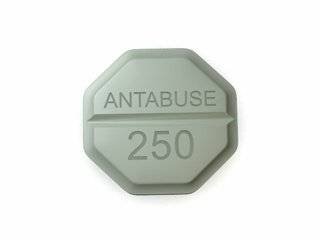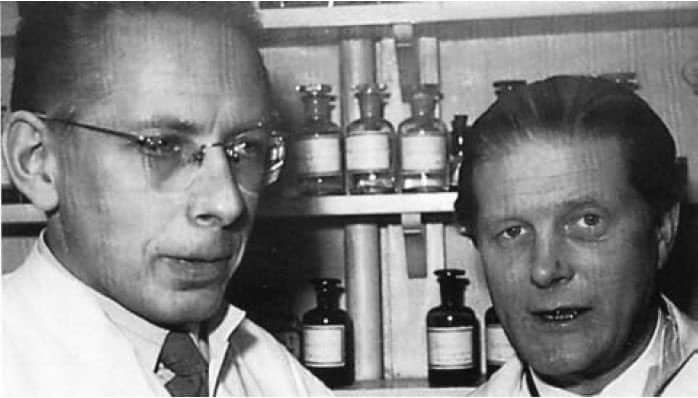There’s a barber on my street called Ish’s, and it’s been there for years. When I was little, Ish would cut my hair. Back when my father had hair, even he would go see Ish to get it cut. Just last week Ish fixed me up again. The reason he’s had his shop for over thirty years is because he does business right. You won’t last selling anything if it doesn’t work, or if buyers aren’t satisfied.
 Disulfiram, most commonly marketed as Antabuse, has been around much longer than Ish’s. Since the 1950s, it’s been used as a highly successful deterrent from alcohol. Actually, the full history of disulfiram is a great story. (See section below!)
Disulfiram, most commonly marketed as Antabuse, has been around much longer than Ish’s. Since the 1950s, it’s been used as a highly successful deterrent from alcohol. Actually, the full history of disulfiram is a great story. (See section below!)
Unlike other anti-alcoholism medications, which work psychologically, and/or ease mental or physical pain, and/or assist in bodily processes, disulfiram just makes you feel like crap if you drink. It’s pretty ingenious, really. With disulfiram in your system, alcohol makes you feel like you have a vicious hangover.
It’s a little more complicated than that, but not by much. Disulfiram works by interrupting how the body processes alcohol. Usually, the body breaks alcohol down into something called ‘acetaldehyde’. From there, the liver processes it further, into something called ‘aldehyde dehydrogenase’. Disulfiram prevents this second step, causing a build-up of acetaldehyde.
“High levels of acetaldehyde act directly on the heart and blood vessels, causing flushing, a racing heartbeat and a drop in blood pressure that causes dizziness. Other unpleasant symptoms include a throbbing headache, shortness of breath, palpitations, nausea and vomiting. This reaction to alcohol is often called the disulfiram reaction and is usually enough to deter people from having another drink.”
Disulfiram treatment may be the best option for recovering alcoholics to stay abstinent.
Sounds Dangerous…
With so many adverse side effects, one might want to ask if the dangers of disulfiram outweigh the benefits. Those listed above are the common side effects. More rare side effects of disulfiram include cardiovascular collapse, arrhythmia, acute congestive heart failure, hepatitis, and even death. It sounds rather dangerous, right?
Disulfiram is infinitely safer than abusing alcohol. Experiencing any side effects other than the common ones is extremely rare. The National Library of Medicine considers alcohol dependence to be “associated with a high morbidity and mortality,” whereas disulfiram is considered to have “a moderate record of adverse effects.”
Only one in 30,000 users develops hepatitis. Since 1997, the total number of users to even experience side effects is only 752! Plus, as seen below, only twelve users have ever died as a result of side effects.
It Really Works
Disulfiram use is controversial, because of its capability to produce such negative effects in users, especially in those who drink alcohol while using it. Medical ethics actually dictates that users are fully informed of all side effects, and the fact that they may (in rare cases) last up to two weeks. In the US, disulfiram has been replaced as the most used drug for alcoholism, by newer drugs that attempt to physiologically ‘fix’ the addiction, reduce craving, and restore normalcy in the brain.
Still, disulfiram really works.
In a 2014 study published by the National Library of Medicine (NLM), a team of researchers set out to fully determine the effectiveness of disulfiram for alcohol dependence treatment. They analyzed 22 previously performed disulfiram studies, and found disulfiram to be more than simply effective:
“Based on results with open-label studies, disulfiram is a safe and efficacious treatment compared to other abstinence supportive pharmacological treatments or to no disulfiram in supervised studies for problems of alcohol abuse or dependence.”
In other words, disulfiram works better than most other drugs for alcohol dependence treatment. The NLM study found its success rate to be between 48% and 57%. More importantly perhaps, the highest success rates came with open-label trials, meaning the participants knew exactly what they were taking.
The Max Planck Institute Study
Disulfiram works long-term as well as immediately. The NLM study proved the effectiveness of disulfiram through studies of the past. Its conclusions were heavily reinforced in December of 2015, when the Max Planck Institute of Experimental Medicine published the results of their nine-year-long study of disulfiram.
Disulfiram was shown to have a success rate of over 50% among the 180 participants. However, psychological changes occurred among those ninety-something people. Alcohol was being physically avoided, yes, but a lifestyle of abstinence was developed.
Hannelore Ehrenreich led the research team. She believes the most important finding of her team’s study was the psychological effectiveness of disulfiram, saying, “The psychological role that alcohol deterrents may play in relapse prevention is one of the most interesting aspects of the study. These results support the theory that prolonged abstinence achieved with disulfiram automatically leads to the consolidation of the habit of abstinence. Practice makes perfect.”
It really is quite simple. Disulfiram makes it so you can’t get drunk. Over enough time, sobriety becomes the norm again, and the addiction is cured. Ehrenreich likens it to slowing down for an inactive traffic camera.
If a driver sees a camera that is tracking speed, he or she is going to slow down, whether that camera is active or not. The driver cannot know the camera is inactive. If having disulfiram in your system is the camera being active, and not having disulfiram in your system is the camera being inactive, the goal is to abstain from drinking either way. Eventually you will not even acknowledge whether or not the camera (disulfiram) is active.
Not a Lone Wolf
Be clear that disulfiram alone is not the answer to alcoholism. Incorporating the deterrent into a treatment program with proper supervision is the key. Says Ehrenreich, “Our results support a major clinical implication, that severe alcoholism is a chronic and relapsing disease. Only long-term treatment, followed by life-long attending of check-up sessions and self-help group participation will guarantee long-term recovery.”
The recommendation given by the Max Planck study is to utilize the psychological aspect of disulfiram more so than the actual drug effect. In other words, patients should focus on abstaining from alcohol and getting rid of the craving, rather than on how drinking would make them sick.
In America, as mentioned, disulfiram has lost some of its popularity. Although still prescribed throughout the country, other forms of medication have surpassed disulfiram. However, in Europe, disulfiram is readily used. There are two main reasons for this. One is because the newer drugs that replaced disulfiram have a broader approach, and the other is because it’s easy for a patient to simply not take disulfiram and then drink.
We feel disulfiram deserves a second chance at being the main drug against alcoholism. After all, it was the first drug to be FDA-approved for fighting alcoholism. An in-depth look into the history of disulfiram reveals just how effective the drug is. Much like Ish’s on my street, disulfiram has been running strong for decades.
Actually, it’s been running strong for over 135 years.
History of Disulfiram (One Man’s Bravery)
It all started in 1881, with a German chemist named M. Grodzki. Although he wasn’t the brave one referred to in the subtitle above, he did invent disulfiram. He synthesized a compound from thiocarbamide, a substance still used today in textile processing. Not yet called disulfiram, this is what Grodzki made in his lab. However, German chemists were producing large numbers of compounds at that time in history. Grodzki’s new compound received very little attention.
Years later, in the early 1900s, that same compound was named disulfiram. The rubber industry used it in the process of making both natural and synthetic rubbers. Workers were exposed to disulfiram regularly, and worked with it directly. Then, in 1937, an American rubber plant physician named E.E. Williams wrote a medical paper about an effect he thought disulfiram was having on the employees at his plant. He noticed the workers were responding negatively to alcohol, and believed it was related.
He even believed it could cure alcoholism. Nobody followed through on the idea.
“The effect of disulfiram on intake of alcohol was also known in the Swedish rubber boot industry, without any one in Sweden suggesting its possible use as a drug against alcoholism,” as written by Sidsel Eriksen of Copenhagen University in an article on disulfiram. Ironically, the man who did follow through on the idea of making disulfiram an anti-alcoholism drug also represented Copenhagen University.
Erik Jacobsen was a physician and biochemist who became the head of a pharmaceutical company called Medicinalco. It was while working there that in 1948, Jacobsen tried something bold. He knew about an effect disulfiram had on copper. He also that lower lifeforms transported oxygen using copper. Jacobsen believed something very far from what E.E. Williams believed – that disulfiram could potentially cure intestinal worms.
Jacobsen’s bold move is why he is our brave one… he tried disulfiram on himself first. This crazy chemist decided to take a disulfiram tablet, and then head to a dinner party, just to test for any side effects. His lab partner, Jens Hald, worked regularly with disulfiram, and apparently reported some strange side effects over time, including from alcohol consumption.

Anyway, Erik Jacobsen’s bold move paid off. In fact, even though disulfiram was invented back in 1881, and even though he thought it would cure intestinal worms, it was Jacobsen who received fame for using it as an anti-alcoholism drug. Time Magazine even interviewed him that same year (1948) about ‘his’ discovery. The archived issues of Time require a paid subscription to access, however here are some quotes from the interview:
“It only took a few days to confirm that the disulfiram tablets really changed the effect of alcohol in a most unpleasant direction,” said Jacobsen after his self-trial. Here is a full snippet from the Time article:
“Copenhagen’s Dr. Erik Jacobsen, 45, likes to try
out new drugs on himself before giving them to his
patients. One night before going to a dinner party
he swallowed a couple of pills made of tetraethyl-thiuram-
disulfide; they were supposed to be good
for intestinal worms. To his surprise, Dr. Jacobsen
found that any form of alcohol revolted him. When
he sipped even a small glass of beer, his face got red,
his heart started to pound, and he had trouble getting
his breath.”
Jacobsen and Hald would go on to invent Antabuse in time. The entire existence of disulfiram as an alcohol deterrent is thanks to one brave man who self-experimented with what he thought was a pill for stomach worms. What a beautiful mistake!
In Conclusion
There is one huge problem with disulfiram. Only about 20% of those who have it prescribed to them actually follow the medical regimen. Without supervision, an alcoholic simply has to not take disulfiram in order to satisfy a temptation. Disulfiram must be taken near-daily. This is why it’s best when incorporated into a treatment program. With supervision and medical assistance, disulfiram is an excellent drug.
There are many other drugs that have what is called the disulfiram effect. Some antibiotics, antidiabetics, antifungals, and even consuming a mushroom called the ‘ink cap’ can produce the disulfiram effect. Plus, there is a medication called Temposil, which is essentially the same thing as disulfiram, just weaker and even safer.
For those who do not believe disulfiram to be the answer to recovering from alcoholism, this author poses a question: If such a substance existed for, say, heroin or cocaine, would you promote its use?












